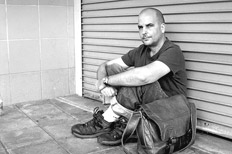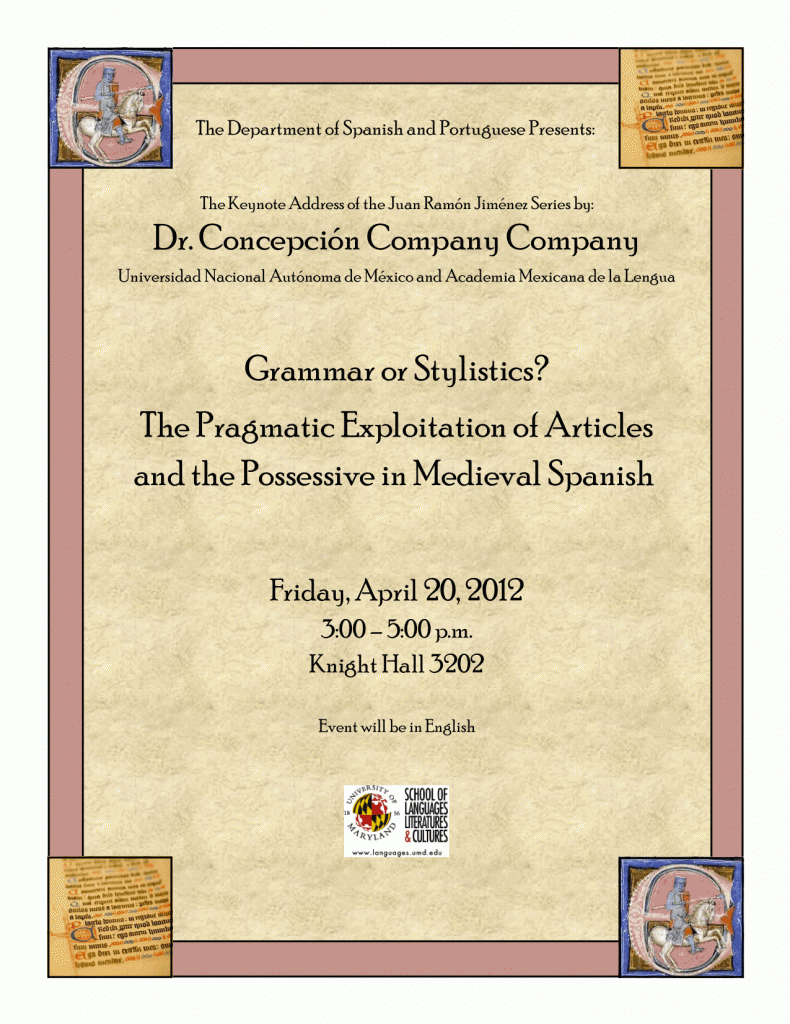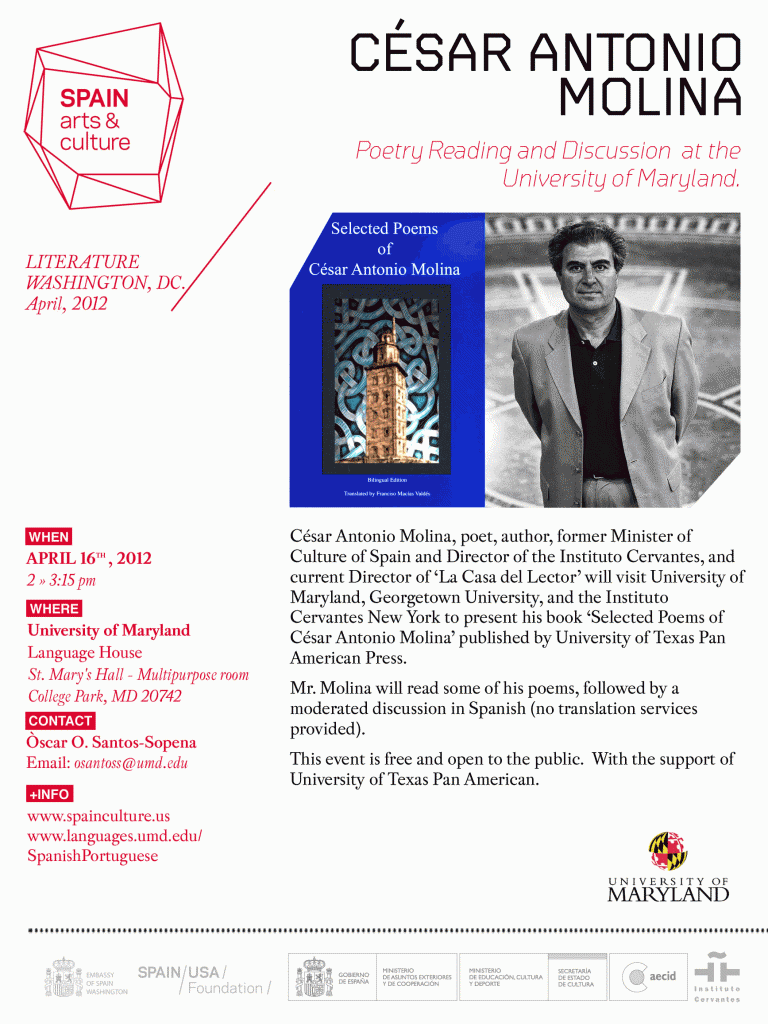A Tribute to José Emilio Pacheco
February 17 at the Mexican Cultural Institute
The University of Maryland’s Department of Spanish and Portuguese and the School of Languages Literatures and Cultures, in collaboration with the Mexican Cultural Institute, are proud to present A Tribute to José Emilio Pacheco. This tribute will honor the lauded Mexican writer José Emilio Pacheco (2009 Cervantes Award Winner) a year after his death with discussion and readings. The event will feature special guest, Cristina Pacheco, prominent Mexican journalist and Pacheco’s wife. Also in attendance will be scholars Saúl Sosnowski and Hernán Sánchez Martínez de Pinillos. Join us at this celebration of José Emilio Pacheco’s extraordinary life and work.
El Departamento de Español y Portugués y la Escuela de Literatura y Culturas de la Universidad de Maryland, en colaboración con el Instituto Cultural de México, se enorgullecen en presentar Un homenaje a José Emilio Pacheco. Este diálogo y lectura de la obra de Pacheco honrará la memoria del galardonado escritor mexicano (Premio Cervantes 2009) a un año de su fallecimiento. En el evento participará como invitada especial Cristina Pacheco, destacada periodista mexicana y esposa del escritor, así como los acádemicos expertos en literatura hispana Saúl Sosnowski y Hernán Sánchez Martínez de Pinillos. ¡Acompáñenos en esta celebración a la vida y obra de José Emilio Pacheco!
More info: http://www.instituteofmexicodc.org/index.php#pacheco
This event will be held in Spanish
La ciudad no es una isla: Sobre Eduardo Lalo, Simone y la literatura puertorriqueña
La ciudad no es una isla

Cuando hace poco más de un mes el puertorriqueño Eduardo Lalo recibió el premio Rómulo Gallegos por su novela Simone, la sorpresa fue grata, más aún si se tiene en cuenta que el libro ya estaba publicadoen Argentina por Corregidor, en 2011. La obra de Lalo se abre al ensayo personal, el fragmento y el cruce con lo visual a partir de dibujos y fotografías, y sobre todo reivindica una relación cultural profunda con la zona del Caribe, y en su conjunto con América latina.
 Por Susana Cella
Por Susana Cella
Casi nadie reparó en la publicación, en 2011, por parte de una editorial argentina, de la novela titulada Simone, del puertorriqueño Eduardo Lalo. Fue dos años después, cuando, precisamente por este texto, ganó el conocido premio Rómulo Gallegos, que logró despertar interés respecto de su propia trayectoria, y también, quizá, como proyección, de la literatura contemporánea de esa isla caribeña. Entre los jurados estuvo Ricardo Piglia, quien destacó, además de los méritos de la obra, un suelo común: “Puerto Rico es un país latinoamericano, nos sentimos latinoamericanos. Somos una cultura de resistencia”. En sintonía con la opinión de Piglia, y en diálogo para esta nota sobre su reciente premio, Lalo señala: “He comentado mucho la invisibilidad de Puerto Rico. Esto me ha ayudado a pensar muchos asuntos del mundo. No somos una aberración, sino la frontera extrema de América latina. En este sentido nos encontramos en un continuo y hemos sido siempre un territorio de peligros y seducciones, pero también de resistencias”. Y esta resistencia ancla fuertemente en la preservación de la lengua castellana para incluirse en la tradición literaria compartida con el resto de las ex colonias españolas frente a los intentos de imposición del inglés, en ese estado libre asociado, de la metrópoli yanqui.
Se trata entonces de una identidad que en la obra se manifiesta a partir de un preciso lugar que determina cómo y qué se enuncia: “Mi trabajo se centra en mi país pero no se limita a él. Más que una serie de circunstancias históricas, interpreto a Puerto Rico como una condición. En este sentido lo exploro, lo investigo, lo pienso sabiendo que es mi único lugar en el mundo, un lugar que amo y me duele como ningún otro. Mi vida transcurrió sobre estas calles, aquí conocí todas las palabras del mundo”.
Antes de Simone, reunió en La isla silente tres libros misceláneos (En el Burger King de la Calle San Francisco; Libro de textos y Ciudades e islas). Siguieron Los pies de San Juan y donde (que incorporan la imagen visual), luego una novela, La inutilidad. Desde el primer título, queda de manifiesto tanto la importancia otorgada a su lugar de origen (isla, Puerto Rico, San Juan) como a los espacios urbanos. Los países invisibles, de 2008, reafirman estos rasgos en una escritura montada sobre desplazamientos, tanto por muchos lugares como en cuanto al paso de un género a otro, por ejemplo relatos de viaje, crónica, crítica, tramos introspectivos y aun testimonio. Así, en El deseo del lápiz: castigo, urbanismo, escritura, con el espesor resultante de ser un libro donde se incorporan y se reflexiona sobre escritos y dibujos de presos de una cárcel de San Juan, mediante la foto y el ensayo.
José Kozer | Premio de Poesía Pablo Neruda 2013

Hijo de padres judíos —padre polaco y madre checoslovaca— exiliados en La Habana durante las postrimerías de la década de 1920, José Kozer (La Habana, 1940) creció, como testimonia uno de sus poemas, escuchando balbucear “verbos de/ yiddish a español”. Esto es, justo en ese espacio de lindes, donde ni siquiera el idioma materno se muestra estable o definido.
Luego de una niñez y primera juventud vividas también en las lindes: entre el castellano insular y la ascendencia judía-centroeuropea legada por los padres (“Yo me presento colérico y arrollador ante/ este libro anguloso,/ yo me presento como un rabino a bailar una/ polca soberana”), la familia Kozer se tiene que exiliar en 1960 nuevamente a raíz del triunfo de la “Revolución” cubana de 1959, esta vez en los Estados Unidos. Los padres y hermana se radicaron en Miami —con intervalo de unos pocos años en México—, y en el caso de José, en la ciudad de Nueva York.
Ya instalado en Nueva York, Kozer experimenta el choque con otra lengua (el inglés), y por ende la adaptación a otros códigos de convivencia, las mil y una labores para buscarse el pan, un primer matrimonio que fracasa, los hijos, un segundo matrimonio con Guadalupe (la esposa que lo acerca nuevamente al castellano), el oficio de profesor de literatura y lengua españolas en Queens College, la decisión de vivir para (en) los poemas.
De 1972 a 1999 alternaría la vida neoyorkina con estancias de verano en España, para entonces establecerse en Hallandale Beach (Florida), donde radica en la actualidad, y donde día a día hace un poema:
Ahí, desde mis cuarenta años de edad, y hasta la fecha, me comenzó a ocurrir: en lugar de buscar al poema, el poema me empezó a buscar a mí, y, digamos, en vez de ser yo su amanuense, el escritor de su escritura, pasé a ser su alfarero, el oficiante de su arcilla (Einstein repite varias veces en sus breves diarios: “Ahora la inspiración ha venido a mí”).[i]
Más aquí: José Kozer | Diario de Cuba.
“Acabo de ver que Kirchner se desvanecía a través de una puerta”
Adelanto exclusivo del último libro póstumo de Fogwill sobre sus sueños.
Claro que vivo. Pero esto es provisorio. Permanente es lo que no vivo. Se dice: “Ay …¡si uno pudiera…!”. Pero no. No pudiera, uno. Y aunque se pudriese conjugando como es debido, uno jamás podría. (…) Mmmmmmm de mudo. La mutación del alma, más buena letra y a otra cosa. Por ejemplo, al relato. Había una vez que yo soñé algo y lo olvidé. Ese sueño y sus no imágenes me siguen hasta hoy, cuando han pasado casi treinta y nueve años. A eso se llama vivir, o haber vivido, pendiente de un olvido. Es natural ahora, cuando el olvido roe las neuronas, pero aún recuerdo que aquella vez, hace casi cuarenta años, soñé y olvidé y desde entonces pienso que el grueso de la memoria se compone de cosas negras hechas de puro olvido. La memoria está llena de olvido, llena de olvido, vacía de sí, llena de olvido, casi hecha de puro olvido. Uno mismo termina hecho de puro olvido. Durante un tiempo me propuse recordar los sueños, es decir, olvidar el menor número posible de sueños. Joven, pronto imaginé que bastaba tomarlos en serio y recordarlos al despertar y evocarlos un par de veces, un rato después de despertar, para fijarlos en la memoria. Por un tiempo. Parece que el sueño sucede en un espacio (¿será la mente, la conciencia, el interior…?) al que vendrían a caer los sueños siguientes para desplazarlos a otro lado. La nada oscura.
Sueño del 6 de enero
Es el comienzo del ciclo escolar y voy a una escuela de Buenos Aires. En una esquina siembro en el agujero de un árbol unas semillas de marihuana. Después me llevan con una comitiva oficial a una escuela pobre del suburbio y a la vuelta cuento el viaje y paso por mi esquina. Una planta ha crecido y florece. No me atrevo a cosecharla, pero al alejarme, veo que un hippoide se acerca y la reconoce. Tal vez la robe.
Continúa acá abajo:
“Acabo de ver que Kirchner se desvanecía a través de una puerta”.
Queer Baroque: Nestor Perlongher takes a stroll down the Parque Lezama
Rubén Ríos Ávila
The distinguished Professor Ruben Rios Avilia will present his study of the exploration of the intersection of baroque poetry and queer theory through the comparison of the poetics of Cuban neo-baroque poet José Lezama Lima and Argentinian queer activist and neo-baroque poet Nestor Perlongher. The analogy will be explored from the stand-point of Góngora’s poetics and Deleuze’s philosophy of the fold.
He will also be meeting with Graduate Students for further discussion on Friday, November 16th at 3:30 PM in the Sala Pacheco, 2215 JMZ
Oscar Santos Sopena receives the 2012 Graduate Student Minority Achievement Award
Our graduate student, Oscar Santos, have been selected to receive the 2012 Graduate Student Minority Achievement Award to recognize the many outstanding contributions and accomplishments he has made for the University. The awards ceremony will be held on Thursday, May 10th at 4:00pm – 5:30pm in the Maryland Room, Marie Mount Hall. Oscar will also get a congratulatory letter from President Loh in a few days. Please feel free to invite your family, friends, and colleagues to the ceremony. Invitations will be forwarded to all vice-presidents, deans, directors, and department chairs,as well as many other members of the campus community.
Felicitaciones, te lo mereces, Oscar.
EL RAPTO DE EUROPA presented by los Jimediantes Theatre Company
The Department of Spanish & Portuguese, School of Languages, Literatures and Cultures, presents Los Jimediantes Theatre Company in EL RAPTO DE EUROPA/ THE RAPTURE OF EUROPE
by Max Aub
The Spanish Civil War, Refugees, Concentration Camps, NGOs, France and World War II Resistance…
College Park, MD – Los Jimediantes, the newly founded theater company of the Department of Spanish and Portuguese, School of Languages, Literatures, and Cultures at the University of Maryland, makes its debut with
The Rapture of Europe (1943) by acclaimed Spanish playwright Max Aub. Adapted and directed by José María Naharro-Calderón, The Rapture of Europe will be presented in Spanish, English, French, Italian and German with English supertitles at 7:30 pm on consecutive Thursdays, May 3rd and May 10th, 2012, in the Ulrich Recital Hall, Tawes Fine Arts Building, University of Maryland, College Park. This performance is free of charge and a reception will follow the opening night’s performance.
ABOUT THE PRODUCTION
In the same vein as the masterpiece works of theater by Bertold Brecht, and rooted in powerful experiential testimony, The Rapture of Europe, also known as, Something Can Always Be Done by Max Aub, reveals the ins and outs of the international resistance network in Marseilles during World War II. In particular, it focuses on the work of the Emergency Rescue Committee (ERC), one of the organizations that took charge between 1940 and 1942 of facilitating the escapes of a group of European intellectuals and resistance leaders whose lives were put in danger by totalitarian and fascist regimes across Europe. This cohort included but was not limited to: Anna Arendt, Walter Benjamin, André Breton, Marc Chagall, Marcel Duchamp, Max Ernst, Wassili Kandinsky, Clara Malraux, Benjamin Péret, Anna Seghers, Victor Serge, Remedios Varo, and Max Aub. It is a clandestine world that the playwright brings to life through the experiences of his protagonist, Margaret Palmer, (a friend of the journalist Jay Allen [Bob] who conflicts with another director of the ERC, Varian Fry), the anguish and needs of the refugees [Anna, Francisco], the aid provided by the Mexican consulate under the charge of Gilberto Bosques, and the lack of political support from the United States [Hope]. Also represented in the play are ideological resistance [Bozzi], the gangster types interested in making a profit by any means necessary [Roger], the strength and ethics of the persecuted Spanish Republicans, and the tremulous relationship that pits Rafael between Adela, his lover, and Luisa, his wife. The duality between troubled love and solidarity is reminiscent of the movie Casablanca (1942). But where The Rapture of Europe departs from Michael Curtiz’s film is in the prominence of the female trio (Margaret, Adela, Luisa), revealing the author’s feelings toward a world in which masculine heroes like Rafael end up playing a secondary role.
Threatened by inhumane acts, in Aub’s universe, women rise above social and genre barriers to participate in solidarity movements where thousands of tireless hands work to preserve universal principles, such as liberty, democracy and human dignity. This is the story of a world torn apart by the threat of fascist and nazi totalitarianisms like ours may be crumbling today under financial stings and civil liberties curtailments. The play touches particularly upon this latter threat as denounced by Holocaust survivors like Primo Levi and may reflect contemporary issues such as the plight of economic refugees, unemployed persons, and the homeless: the 99% of the Occupy Wall Street Movement. These new “others” have shifted the diaspora of Aub’s characters but not the importance of their call to action.
ABOUT THE PLAYWRIGHT
Max Aub Mohrenwitz (Paris 1903-Mexico City 1972) is a transnational writer avant la lettre and one of the most brilliant Spanish intellectuals of the 20th century. At the beginning of World War I in 1914, his family took refuge in Valencia (Spain) where Max was naturalized and later began his writing career solely in Spanish. After the outbreak of the Spanish Civil War in July 1936, he was sent to Paris as the Cultural Attaché at the Embassy of the Spanish Republic. There he also acted as coordinator of the Spanish Pavilion at the International Exposition of 1937, where he skillfully presented for the first time Pablo Picasso’s Guernica, the exposition’s center piece. After the defeat of Republican Spain (1939), Aub was unable to board in France any of the ships freighted by the Spanish Republic in exile. He managed to live quietly in Paris until this agnostic social humanist was denounced anonymously and calumniously as a dangerous communist militant of Jewish confession. He was consequently arrested by the French authorities of the Third Republic (1870-1940) and sent to the concentration camp in Le Vernet d’Ariège along with other prominent European antifascists (Arthur Koestler, Rudolf Leonhard, Francesco Nitti, Gustav Regler). He was eventually released and assigned to a residence in Marseilles, where he was protected by his friend, the protagonist of The Rapture of Europe, Margaret Palmer, co-worker of Varian Fry’s Emergency Rescue Committee. Detained again in September 1941 and sent back to Le Vernet d’Ariège by the Vichy authorities (1940-44), he was then deported to one of the several French colonial concentration camps, the ominous Djelfa enclave in Algeria. In May 1942, he managed to escape and hide in Casablanca until sailing to Mexico in November, 1942.
Among his other works are his pentalogy on the Spanish Civil War: The Spanish Labyrinth (1943-1968); his masterpieces on the concentration camps (poetry, short stories and a film script): Diario de Djlefa (1944), Manuscrito cuervo (1955), and Campo francés (1965); his “Major Theater”: San Juan (1942), El Rapto de Europa (1943) [premiere in English in Pasadena, 1945], Morir por cerrar los ojos (1944), No (1951); his spoof on Picasso’s pseudo artist friend: Josep Torres Campalans (1958); his foreshadowing diary after his 1969 visit to Franco’s Spain, La gallina ciega (1973); his essays: Hablo como hombre (1951); and his histories and biographies: Manual de historia de la literatura española (1974), and Conversaciones con Buñuel (1984).
ABOUT THE DIRECTOR
Dr. José M. Naharro-Calderón has always enjoyed the stage. His last role was M. Martin in Eugène Ionesco’s
La cantatrice chauve. Dr. Naharro-Calderón is an Associate Professor at the University of Maryland. He teaches Spanish contemporary literature, culture, film, and exile studies.
ABOUT THE CAST
Los Jimediantes Theatre Company is composed entirely of faculty and students of the University of Maryland. The Rapture of Europe is performed by Sebastián Delta (Bozzi), Mario Escobar (Rafael), Andrea Fanta (Margarita in Spanish), María Gómez-Martín (Luisa), Chris Lewis (Bob), Andrew Milacci (Hope), Lina Morales-Chacana (Anna), José M. Naharro-Calderón (Francisco), Òscar Santos-Sopena (Bellboy), Leonardo Solano (Roger), and Lisa Warren (Margaret in English). Set design and costumes by Los Jimediantes and Natasha Joyce. Stage manager and sound by Nicholas Boltz and supertitles and projections by Lindsay Kermisch. Ushers: Abigail Barenblitt and Sarah Woolsey.





